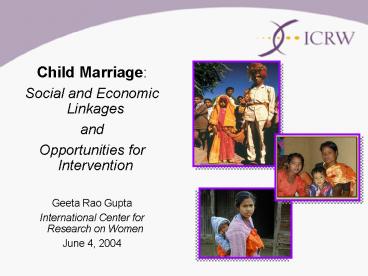Child Marriage: - PowerPoint PPT Presentation
1 / 16
Title:
Child Marriage:
Description:
Child Marriage Undermines Economic Development and the Achievement of the MDGs ... resulted in some hopeful outcomes in age of marriage as compared with a control ... – PowerPoint PPT presentation
Number of Views:2814
Avg rating:3.0/5.0
Title: Child Marriage:
1
- Child Marriage
- Social and Economic Linkages
- and
- Opportunities for Intervention
- Geeta Rao Gupta
- International Center for Research on Women
- June 4, 2004
2
Child Marriage Undermines Economic Development
and the Achievement of the MDGs
- Goal 1 Eradicate extreme poverty and hunger
- Goal 2 Achieve universal primary education
- Goal 3 Promote gender equality and empower
women - Goal 4 Reduce child mortality
- Goal 5 Improve maternal health
- Goal 6 Combat HIV/AIDS, malaria and other
diseases
From Save the Children, State of the Worlds
Mothers 2004
3
Economic Motivations for Child Marriage
- Marriage is an economic transaction
- Costs are lower and gains are higher when
marriage occurs at an early age - Child marriage is caused by the tyranny of poverty
4
The Link is Clear
- It is no coincidence that the same countries in
Africa, Asia and the Middle East that have high
rates of child marriage are also those with - High poverty rates, birth rates, death rates.
- Greater incidence of conflict and civil strife
- Lower levels of overall development, including
schooling, employment, health care.
5
And, conversely.
- The East Asian Miracles like Taiwan, South
Korea, Thailand, that have successfully
eradicated the harmful traditional practice of
child marriage, are characterized by - Economic growth and opportunity
- Declines in birth and death rates
- Increases in educational and employment options
for girls
6
Child Marriage and Rank on Human Development
Index (HDI)
7
Life Consequences for Girls and Families
- Early, unwanted pregnancies and unwanted children
- Increased risk of maternal and infant mortality
- Increased vulnerability to HIV and other STIs
- Burden of motherhood, domestic responsibilities
from young age - Lack of education
- Lack of skills to be viable in the labor market
- Limited social support, because of social
isolation
8
Percent Girls Marrying Before Age 18 and
Enrollment in Secondary School
9
Maternal Mortality by Age
10
Infant Mortality Rates by Age of the Mother
11
For Society, these Consequences Mean
- Wasted potential of each generation of young
girls to become contributing citizens and
empowered women. - An intergenerational cycle of poverty,
disempowerment, ill-health, and disease.
12
Delay Marriage by Providing EconomicOpportunities
- In Bangladesh, young womens employment in the
garment industry has played an important role in
increasing the age of marriage (Amin et al.
1998). - In India, state governments have developed
programs that allow young women to receive the
money that the state has invested in them at
birth only if they complete a certain level of
schooling and remain unmarried (Government of
Manipur 1997)
13
Delay Marriage by Educating Girls
- In India and Pakistan, increased school
enrollment has been associated with a decline in
marriage among girls before age 14 (Hussain and
Bittles 1999 Unisa 1995) - The acceptance of education as desirable for
girls has been a critical factor in increasing
age of marriage in Indonesia, Taiwan, Thailand,
and Sri Lanka.
14
Delay Marriage by Community Education
- In Maharashtra, India, a community intervention
which included - a life skills program for girls 11 to 18 years,
- meeting with parents of those who participated in
the program and of those who did not, and - the availability of primary health care for all
girls in the community
resulted in some hopeful outcomes in age of
marriage as compared with a control community
(Khale et al. 2004).
15
Results of the Community Interventionin
Maharashtra Median age at marriage and girls
getting married before 18 years
16
Promises to Keep
- Increase the age of marriage
- Support married adolescent girls through
education and livelihood opportunities - Empower unmarried girls who are at risk































